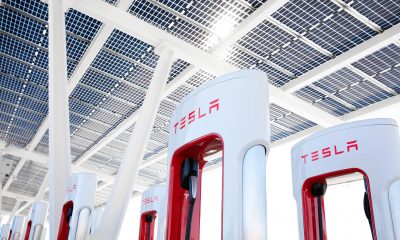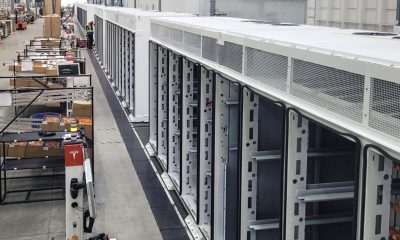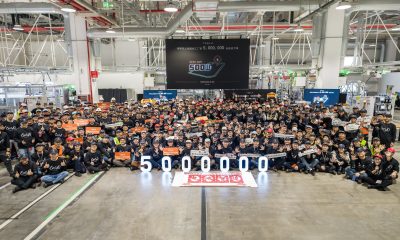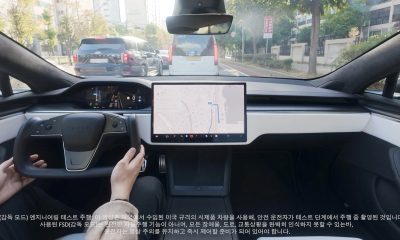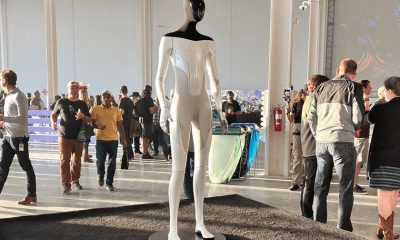Energy
Tesla’s new Megablock system can power 400,000 homes in under a month
Tesla also unveiled the Megapack 3, the latest iteration of its flagship utility scale battery.

Tesla has unveiled the Megablock and Megapack 3, the latest additions to its industrial-scale battery storage solution lineup.
The products highlight Tesla Energy’s growing role in the company, as well as the division’s growing efforts to provide sustainable energy solutions for industrial-scale applications.
Megablock targets speed and scale
During the “Las Megas” event in Las Vegas, Tesla launched Megablock, a pre-engineered medium-voltage block designed to integrate Megapack 3 units in a plug-and-play system. Capable of 20 MWh AC with a 25-year life cycle and more than 10,000 cycles, the Megablock could achieve 91% round-trip efficiency at medium voltage, inclusive of auxiliary loads.
Tesla emphasized that Megablock can be installed 23% faster with up to 40% lower construction costs. The platform eliminates above-ground cabling through a new flexible busbar assembly and delivers site-level density of 248 MWh per acre. With Megablock, Tesla is also aiming to commission 1 GWh in just 20 business days, or enough to power 400,000 homes in less than a month.
“With Megablock, we are targeting to commission 1 GWh in 20 business days, which is the equivalent of bringing power to 400,000 homes in less than a month. It’s crazy. How are we planning to do that? Like most things at Tesla, we are ruthlessly attacking every opportunity to save our customers time, simplify the process, remove steps, (and) automate as much as we can,” the company said.
Megapack 3 is all about simplicity
The Megapack 3 is Tesla’s next-generation utility battery, designed with a simplified architecture that cuts 78% of connections compared to the previous version. Its thermal bay is drastically simplified, and it uses a Model Y heat pump on steroids. The battery weighs about 86,000 pounds and holds 5 MWh of usable AC energy. Tesla engineers incorporated a larger battery module and a new 2.8-liter LFP cell co-developed with the company’s cell team.
The Megapack 3 is designed for serviceability, and it features easier front access and no roof penetrations. About 75% of Megapack 3’s total mass is battery cells, with individual modules weighing as much as a Cybertruck. It’s also tough, with an ambient operating temperature range from -40C to 60C. This should allow the Megapack 3 to operate optimally from the coldest to the hottest regions on the planet.
Production is set to begin at Tesla’s Houston Megafactory in late 2026, with planned capacity of 50 GWh per year. Additional supply will come from Tesla’s 7 GWh LFP facility in Nevada, which is expected to open in 2025, as well as with third-party partners.
Energy
Tesla starts hiring efforts for Texas Megafactory
Tesla’s Brookshire site is expected to produce 10,000 Megapacks annually, equal to 40 gigawatt hours of energy storage.

Tesla has officially begun hiring for its new $200 million Megafactory in Brookshire, Texas, a manufacturing hub expected to employ 1,500 people by 2028. The facility, which will build Tesla’s grid-scale Megapack batteries, is part of the company’s growing energy storage footprint.
Tesla’s hiring efforts for the Texas Megafactory are hinted at by the job openings currently active on the company’s Careers website.
Tesla’s Texas Megafactory
Tesla’s Brookshire site is expected to produce 10,000 Megapacks annually, equal to 40 gigawatt hours of energy storage, similar to the Lathrop Megafactory in California. Tesla’s Careers website currently lists over 30 job openings for the site, from engineers, welders, and project managers. Each of the openings is listed for Brookshire, Texas.
The company has leased two buildings in Empire West Business Park, with over $194 million in combined property and equipment investment. Tesla’s agreement with Waller County includes a 60% property tax abatement, contingent on meeting employment benchmarks: 375 jobs by 2026, 750 by 2027, and 1,500 by 2028, as noted in a report from the Houston Business Journal. Tesla is required to employ at least 1,500 workers in the facility through the rest of the 10-year abatement period.
Tesla’s clean energy boom
City officials have stated that Tesla’s arrival marks a turning point for the Texas city, as it highlights a shift from logistics to advanced clean energy manufacturing. Ramiro Bautista from Brookshire’s economic development office, highlighted this in a comment to the Journal.
“(Tesla) has great-paying jobs. Not just that, but the advanced manufacturing (and) clean energy is coming to the area,” he said. “So it’s not just your normal logistics manufacturing. This is advanced manufacturing coming to this area, and this brings a different type of job and investment into the local economy.”
Energy
Tesla and Samsung SDI in talks over new US battery storage deal: report
The update was related by industry sources and initially reported by South Korean news outlets.

Recent reports have suggested that Tesla and Samsung SDI are in talks over a potential partnership to supply batteries for large-scale energy storage systems (ESS).
The update was related by industry sources and initially reported by South Korean news outlets.
ESS batteries to be built at Samsung’s Indiana plant
As noted in a report from Korea JoongAng Daily, the demand for energy storage systems has been growing rapidly in North America, thanks in no small part to the surge in AI investments across numerous companies. With this in mind, Tesla has reportedly approached Samsung SDI about a potential battery supply deal.
The deal is reportedly worth over 3 trillion Korean won (approximately $2.11 billion) and will span three years, according to The Korea Global Economic Daily. A battery supply deal with Samsung SDI could make sense for Tesla as the company already has a grid-scale battery, the Megapack, which is perfect for industrial use. Samsung SDI could simply supply cells for the EV maker.
Production of the batteries would reportedly take place at Samsung SDI’s joint venture factory with Stellantis in Indiana, which is currently under construction. Samsung SDI recently announced plans to use part of that plant’s EV lines to produce cells for ESS, with a targeted capacity of 30 GWh by the end of next year.
Tesla and Samsung’s partnership
At present, only a handful of manufacturers, including Korea’s LG Energy Solution, Samsung SDI, SK On, and Japan’s Panasonic, are capable of producing energy storage-scale batteries domestically in the United States. A Samsung SDI official issued a comment about the matter, stating, “Nothing has been finalized regarding cooperation with Tesla.”
The possible energy storage system deal adds another layer to Tesla’s growing collaboration with Samsung, which is already in line as a partner in the upcoming production of Tesla’s AI5 and AI6 chips. Early sample manufacturing of the AI6 is expected to begin in South Korea, with mass production slated for Samsung’s Texas-based Taylor foundry when it starts operations.
The AI6 chip will power Tesla’s next wave of high-volume projects, including the Optimus humanoid robot and the autonomous Cybercab service. Musk has called the partnership with Samsung a “real collaboration,” adding that he personally plans to “walk the line” at the Taylor facility to speed up progress.
Energy
Tesla VP hints at Solar Roof comeback with Giga New York push
The comments hint at possible renewed life for the Solar Roof program, which has seen years of slow growth since its 2016 unveiling.

Tesla’s long-awaited and way underrated Solar Roof may finally be getting its moment. During the company’s Q3 2025 earnings call, Vice President of Energy Engineering Michael Snyder revealed that production of a new residential solar panel has started at Tesla’s Buffalo, New York facility, with shipments to customers beginning in the first quarter of 2026.
The comments hint at possible renewed life for the Solar Roof program, which has seen years of slow growth since its 2016 unveiling.
Tesla Energy’s strong demand
Responding to an investor question about Tesla’s energy backlog, Snyder said demand for Megapack and Powerwall continues to be “really strong” into next year. He also noted positive customer feedback for the company’s new Megablock product, which is expected to start shipping from Houston in 2026.
“We’re seeing remarkable growth in the demand for AI and data center applications as hyperscalers and utilities have seen the versatility of the Megapack product. It increases reliability and relieves grid constraints,” he said.
Snyder also highlighted a “surge in residential solar demand in the US,” attributing the spike to recent policy changes that incentivize home installations. Tesla expects this trend to continue into 2026, helped by the rollout of a new solar lease product that makes adoption more affordable for homeowners.
Possible Solar Roof revival?
Perhaps the most intriguing part of Snyder’s remarks, however, was Tesla’s move to begin production of its “residential solar panel” in Buffalo, New York. He described the new panels as having “industry-leading aesthetics” and shape performance, language Tesla has used to market its Solar Roof tiles in the past.
“We also began production of our Tesla residential solar panel in our Buffalo factory, and we will be shipping that to customers starting Q1. The panel has industry-leading aesthetics and shape performance and demonstrates our continued commitment to US manufacturing,” Snyder said during the Q3 2025 earnings call.
Snyder did not explicitly name the product, though his reference to aesthetics has fueled speculation that Tesla may finally be preparing a large-scale and serious rollout of its Solar Roof line.
Originally unveiled in 2016, the Solar Roof was intended to transform rooftops into clean energy generators without compromising on design. However, despite early enthusiasm, production and installation volumes have remained limited for years. In 2023, a report from Wood Mackenzie claimed that there were only 3,000 operational Solar Roof installations across the United States at the time, far below forecasts. In response, the official Tesla Energy account on X stated that the report was “incorrect by a large margin.”
-

 News5 days ago
News5 days agoTesla shares rare peek at Semi factory’s interior
-

 Elon Musk5 days ago
Elon Musk5 days agoTesla says texting and driving capability is coming ‘in a month or two’
-

 News4 days ago
News4 days agoTesla makes online ordering even easier
-

 News4 days ago
News4 days agoTesla Model Y Performance set for new market entrance in Q1
-

 News5 days ago
News5 days agoTesla Cybercab production starts Q2 2026, Elon Musk confirms
-

 News5 days ago
News5 days agoTesla China expecting full FSD approval in Q1 2026: Elon Musk
-

 News6 days ago
News6 days agoTesla Model Y Performance is rapidly moving toward customer deliveries
-
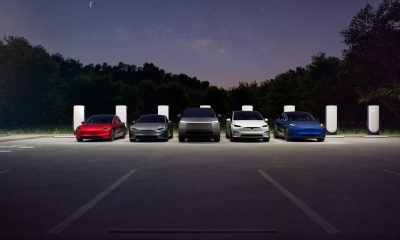
 News3 days ago
News3 days agoTesla is launching a crazy new Rental program with cheap daily rates


